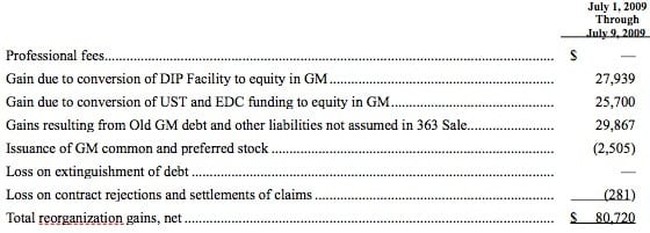Have you heard about the $80.7 billion “reorganization gain” General Motors posted in its recent release of financial information?
I’ll bet not. Specifically, that gargantuan sum is the positive portion of a net amount of $79.672 billion that “old General Motors” — now known as Motors Liquidation Company — recognized as “special items” during the first nine days of July. You read that right.
To reach the details of this most extraordinary gain, the company forces you to download and open a 14-page Word document; I guess the news about that marvelous invention known as Portable Document Format (PDF) has yet to reach Detroit. Finally, the reader sees the line-by-line treatment on page 6:

Allow me to translate:
- After writing off $53.639 billion in “loans,” the federal government has a majority stake in “new” General Motors supposedly valued at $2.505 billion. The difference of $51.134 billion represents the direct amount U.S. taxpayers have lost thus far as a result of bailing the company out.
- The third item is the total of the debts and other general obligations the bankruptcy court in essence allowed GM to walk away from.
This astounding and precedent-breaking set of transactions is news by any reasonable definition of the word. At first, the Associated Press treated it that way. Relatively brief versions of AP reports issued during the first hour or so after GM’s early morning November 16 release noted the $80 billion pickup (pun not intended). But by 9:30, the $80 billion disappeared and never returned; it is nowhere to be found in the final version of the wire service’s coverage. The focus in later revisions moved to further discussion of the “new” GM’s reported “managerial net loss” of $1.2 billion and to the company’s intention to begin repaying some of the additional money that Uncle Sam lent to it after it emerged from bankruptcy. To be clear (which AP wasn’t), the loans targeted for payback are over and above the $50-plus billion already written off.
Although it doesn’t involve huge sums of money, a second recent establishment media disappearing act involves hundreds of thousands of Americans who have always received prominent mention in the run-up to Thanksgiving whenever Republicans have occupied the White House. I am of course referring to the homeless.
Let’s see. Is the economy worse or better than it was two Thanksgivings ago? October 2009’s unemployment rate of 10.2% was 5.5 points higher than October 2007’s 4.7%. The U.S. economy in the third quarter of 2009 was smaller than it was two years earlier, and home foreclosures have dominated the economic news for quite some time.
Given the obviously worse and still deteriorating employment and housing situations, one would think that to the extent the homeless problem is truly serious, it has almost certainly gotten worse overall, and definitely so in certain parts of the country. One might therefore conclude that homelessness would have received more media coverage just before and after this year’s Thanksgiving than it has in previous years, and that enterprising reporters would have rushed out of their comfortable offices to breathlessly tell their audiences how awful the plight of the homeless has become.
That didn’t happen. A Google News search I did on November 29 on “homelessness rising” (not in quotes) returned all of 22 unique listings. I repeated that search on December 2 and got the same results. As far as I could tell, none of the listings were from national establishment media sources and virtually none of them addressed overall national or local trends. Similar searches done two or more years ago while George W. Bush was president would certainly have retrieved far more results.
A third disappearing act has to do with Christmas and Christmas shopping, and has two aspects. Since 2005, I have chronicled the decline in media use of the term “Christmas shopping season” in favor of “holiday shopping season” (typed in quotes in each case). Four years ago, in searches done just before Thanksgiving, “Christmas shopping season” references made up about 15% of the total results of all “shopping season” searches. This year, those references were only 6% of the total. At that rate of shrinkage, we won’t see any references to the “Christmas shopping season” within three or four years.
The other angle disappearing from journalists’ Christmas reporting lists is the one where they go all gloomy telling us what a mediocre selling season retailers will have, are having, and finally did have. This commonly played out at the New York Times during the Bush 43 years of 2001-2007.
This year, it seems that they’re turning into Pollyannas. In Tuesday’s Times, reporter Stephanie Rosenbloom waited until her 15th and final paragraph to tell us that two retail associations predict that overall Christmas shopping season sales will come in 1-2% below last year’s objectively dreadful, bailout blues-induced result.
As I prepared this column, it seemed that the establishment media’s dogged effort to keep Climategate under wraps was starting to unravel. But if they can successfully hide $80 billion, ignore hundreds of thousands of homeless, make the Christmas shopping season disappear, and pretend that Christmas retail business really isn’t that bad, I wouldn’t bet against them on Climategate just yet.









Join the conversation as a VIP Member